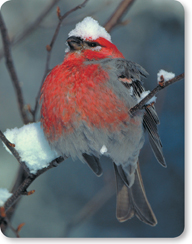Comparing Ectotherms and Endotherms Ectothermy and endothermy each have advantages and disadvantages in different situations. Endotherms move around easily during cool nights or in cold weather because they generate and conserve body heat. That's how musk oxen live in the tundra and killer whales swim through polar seas. But the high metabolic rate that generates this heat requires a lot of fuel. The amount of food needed to keep a single cow alive would be enough to feed ten cow-sized lizards!
Ectothermic animals need much less food than similarly sized endotherms. In environments where temperatures stay warm and fairly constant, ectothermy is a more energy-efficient strategy. But large ectotherms run into trouble if it gets very cold at night or stays cold for long periods. It takes a long time for a large animal to warm up in the sun after a cold night. That's one reason why most large lizards and amphibians live in tropical or subtropical areas.

FIGURE 28–29 Endotherm Insulation Like some of their dinosaur ancestors, modern birds such as this pine grosbeak use feathers to stay warm. When a bird gets cold, its dense, fluffy undercoat of down feathers stands up and creates spaces next to the bird's skin in which body heat is trapped.
Evolution of Temperature Control There is little doubt that the first land vertebrates were ectotherms. But questions remain about when and how often endothermy evolved. Although modern reptiles are ectotherms, a great deal of evidence suggests that at least some dinosaurs were endotherms. Many feathered dinosaur fossils have been discovered recently, suggesting that these animals, like modern birds such as that in Figure 28–29, used feathers for insulation. Current evidence suggests that endothermy has evolved at least twice among vertebrates. It evolved once along the lineage of ancient reptiles that led to birds, and once along the lineage of ancient reptiles that led to mammals.
28.4 Assessment

-
Review How do the immune system and endocrine glands help to maintain homeostasis?
Explain Give an example of how multiple body systems function together to maintain homeostasis.
Apply Concepts Describe how the circulatory and endocrine systems of the migrating wildebeests in Figure 28-26 help them maintain homeostasis.
-
Review Define ectotherm. Define endotherm.
Explain Why must an endotherm eat more food than an ectotherm of the same size?
Form a Hypothesis How might birds and mammals have evolved different means of insulating their bodies?
VISUAL THINKING
Construct a table that compares ectothermy and endothermy. Include the ways body temperature is controlled, relative rates of metabolism, relative amounts of food eaten, advantages, disadvantages, and examples of animals with each method of temperature regulation.

Table of Contents
- Formulas and Equations
- Applying Formulas and Equations
- Mean, Median, and Mode
- Estimation
- Using Measurements in Calculations
- Effects of Measurement Errors
- Accuracy
- Precision
- Comparing Accuracy and Precision
- Significant Figures
- Calculating With Significant Figures
- Scientific Notation
- Calculating With Scientific Notation
- Dimensional Analysis
- Applying Dimensional Analysis




